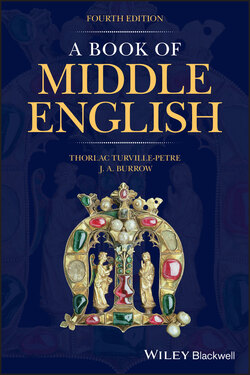Читать книгу A Book of Middle English - J. A. Burrow - Страница 22
2.2.4 The Diphthongs
ОглавлениеOne may start with the assumption that, in Middle English spelling, combinations of vowel‐letters such as ai or au represent (as they rarely do in modern spelling) sequences which begin with the sound indicated by the first letter and end with the sound indicated by the second. Thus, Middle English day was pronounced with /a/ + /i/, as a single syllable, much like modern ‘die’; and Middle English cause has the diphthong of modern ‘cow’, /a/ + /u/. Similarly, eu or ew represent an e sound followed by /u/, which is also as it should be. But note the following:
1 ei originally represented /e/ + /i/; but this diphthong developed into /a/ + /i/ in the thirteenth century. So alwey rhymes with may thereafter.
2 oi commonly represented /o/ + /i/, but also sometimes /u/ + /i/. The two diphthongs occur as alternatives in certain words, e.g. boy.
3 ou or ow represented /o/ + /u/ in such words as foughten; but in words now pronounced with /au/, like ‘house’, they represented /u:/. (See 2.2.1 above.)
4 ea and eo spellings do not represent diphthongs in Middle English, though they had done so in Old English. In each case, the Old English diphthong has become a single vowel sound in Middle English, while retaining the two‐letter spelling. So Middle English ea represents /ε:/; and eo represents /e/ when short, and /e:/ when long. In Early Middle English writings of Western origin such as Laʒamon’s Brut or Ancrene Wisse (texts 3 and 4 here), however, eo is to be pronounced like the vowel in French ‘peuple’ (short or long).
